Kerala Plus One Botany Notes Chapter 3 Morphology of Flowering Plants
Define Morphology:
It is study of external features of a plant i.e presence of roots, stems, leaves, flowers and fruits.
The Root:
Root system:
In dicotyledonous plants, the direct elongation of the radicle leads to the formation of primary root which bears lateral roots that are secondary, tertiary, etc.
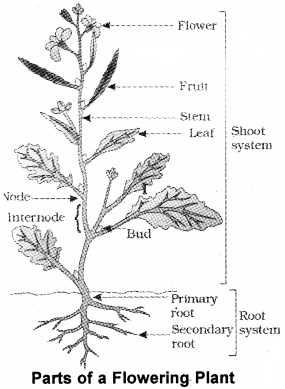
1. Tap root system:
The radical elongate and forms primary root or tap root that bears number of lateral roots. It is found in dicot root. eg: the mustard plant.
2. Fibrous root system:
In monocotyledonous plants, the primary root is short lived from there thin fibre roots originates. eg: wheat plant.
3. Adventitious roots:
In grass, Monstera and the banyan tree, roots arise from parts of the plant other than the radicle.
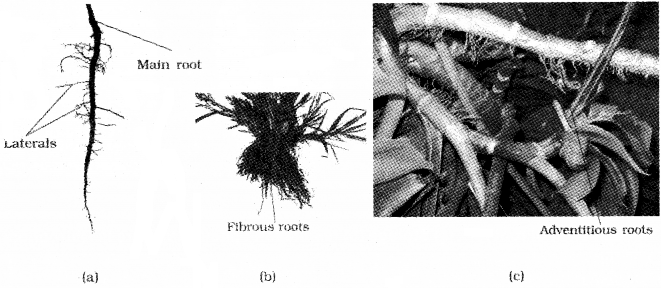
Regions of the Root:
1. Region of Root cap:
It is the covering of root apex that protects the tender apex.
2. Region of Meristem:
This is the region just behind the the root cap that is capable of active cell division.
3. Region of elongation:
The cells proximal to this region undergo rapid elongation and enlargement for the growth
4. Region of maturation:
This is proximal to the region of elongation gradually differentiate and mature
5. Region root hairs:
From the region of maturation root hairs arise. These root hairs absorb water and minerals from the soil.

Modifications of Root:
Roots are modified for
- Mechanical support
- Storage of food
- Respiration
1. Mechanical support:
(a) Prop roots:
In banyan tree, adventitious roots are modified and provide mechanical support
(b) Stilt roots:
In maize and sugarcane adventitious roots are supporting and coming out from the lower nodes of the stem. .
2. Storage of food:
In carrot, turnips tap roots are modified for food storage. In sweet potato adventitious roots are swollen and store food.
3. Respiration:
Rhizophora growing in swampy areas, many roots come out of the ground and grow vertically upwards. Such roots are called pneumatophores.
Function:
It help in the process of respiration.

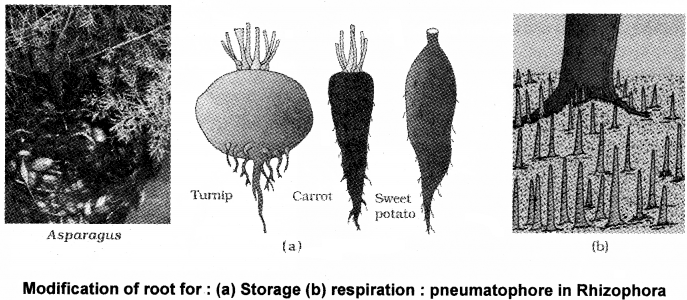
The Stem:
Salient features:
- The stem arise from the plumule of the embryo of a germinating seed.
- The stem bears nodes and internodes.
- The region of the stem where leaves are born are called nodes while internodes are the portions between two nodes.
Function:
Support leaves, flowers and fruits. It also conducts water, minerals and do photosynthesis.
Modifications of Stem:
1. Storage of food:
Underground stems of potato, ginger, turmeric, zaminkand, Colocasia are modified to store food
2. Climbing:
Stem tendrils which develop from axillary buds, are slender and spirally coiled that help the plants to climb. eg: in gourds (cucumber, pumpkins, watermelon) and grapevines.
3. Protection:
Axillary buds of stem are modified into woody, straight and pointed thorns. eg: in Citrus, Bougainvillea Thev nrotect Dlants from browsina animals

4. Photosynthesis:
Some stems are lattened (Opuntia), or fleshy cylindrical (Euphorbia) structures. They contain chlorophyll and carry out photosynthesis.
5. Vegetative propagation:
- In grass and strawberry, etc. stem spread to new niches and when older parts die new plants are formed.
- In mint and jasmine lateral branch arises from the base of the main axis and after growing aerially and arch downwards to touch the ground.
- In Pistia and Eichhornia the lateral branch with short internodes and each node bearing a rosette of leaves and a tuft of roots
- In banana, pineapple and Chrysanthemum, the lateral branches originate from the basal underground portion of the main stem, grow horizontally beneath the soil and then come out obliquely upward giving rise to leafy shoots.
The Leaf:
Salient features:
- It is the flattened structure develops at the node and bears a bud in its axil.
- The axillary bud later develops into a branch.
- They are the most important vegetative organs for photosynthesis.
- some plants leaf base bear two lateral stipules.
- In monocotyledons, the leaf base expands into a sheath covering the stem.
- In some leguminous plants the leaf base become swollen, which is called the pulvinus.
- The lamina or the leaf blade is the green expanded part of the leaf with veins and veinlets.
- The middle prominent vein, which is known as the midrib.
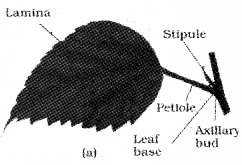
Function of veins:
Veins act as channels of transport for water, minerals and food materials.
A typical leaf consists of three main parts:
- Leaf base
- petiole
- lamina
Venation:
1. Reticulate Venation:
The arrangement of veins and the veinlets in the lamina of leaf. Veinlets repeatedly branched to form a network. eg: dicotyledonous plants.
2. Parallel Venation:
When the veins run parallel to each other within a lamina. eg: monocotyledons plants.
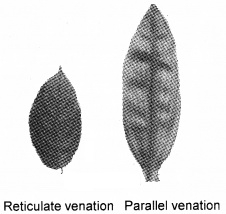
Types of Leaves:
- Siimple leaf: In this lamina is entire or the incisions do not touch the midrib.
- Compound leaf: In this incisions of the lamina reach up to the midrib breaking it into a number of leaflets.
Can you see the bud in the axil of leaflet of compound leaf?
A bud is not present in the axil of leaflets of the compound leaf.
Two types of compound leaves:
- Pinnately compound leaf: Number of leaflets are present on a common axis, the rachis, which represents the midrib of the leaf eg neem.
- Palmately compound leaf: In this leaflets are attached at the tip of petiole, eg silk cotton.
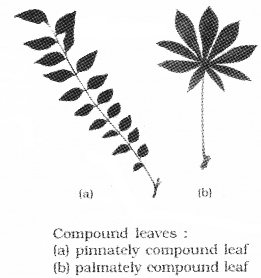
Phyllotaxy:
It is the arrangement of leaves on the stem or branch Three types of phyllotaxy in plants alternate, opposite and whorled.
- Alternate type: A single leaf arises at each node in alternate manner. eg: china rose, mustard and sunflower.
- Opposite type: A pair of leaves arise at each node and lie opposite to each other. eg: Calotropis and guava.
- Whorled type: More than two leaves arise at a node. eg: Alstonia.
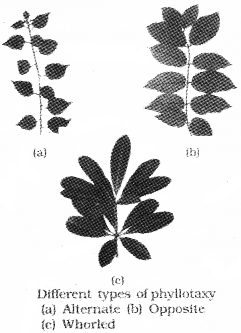
Modifications of Leaves:
- Food storage: The fleshy leaves of onion and garlic store food.
- Protection: The spines are developed in cacti act as organ of defence
- Climbing: In peas Leaves are modified into tendrils for climbing
- Photosynthesis: In Australian acacia, the leaves are small and short-lived. The petioles in these plants expand become green and synthesise food
- Insect capture: In pitcher plant and venus-fly trap (insectivorous plants) leaves are modified for Capturing insects.
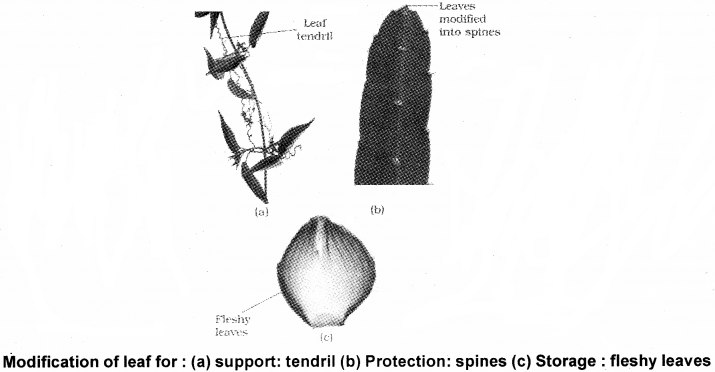
The Inflorescence:
The arrangement of flowers on the floral axis is termed as inflorescence. Two major types of inflorescences are
- Racemose
- Cymose.
How will you differentiate recemose inflorescence from cymose?
In racemose type, the main axis continues to grow, the flowers are arranged in an acropetal succession. In cymose type, the main axis terminates in a flower. The flowers arranged in a basipetal order.

The Flower:
The flower is the reproductive unit in the angiosperms. It consists of different kinds of whorls (calyx, corolla, androecium and Gynoecium) arranged successively on the swollen end of the stalk or pedicel, called thalamus or receptacle.
What are the accessory and reproductive organs?
Calyx and corolla are accessory organs,while androecium and gynoecium are reproductive organs.
Did you see single accessory organ of a flower:
In lily plant, the calyx and corolla are not distinct, it is called as perianth. This is the single accessory organ of a flower. When a flower has both androecium and gynoecium, it is bisexual. A flower having either only stamens or only carpels is unisexual.
1. Actinomorphic Flower:
A flower can be divided into two equal radial halves in any radial plane passing through the centre, eg: mustard, datura, chilli.
2. Zyqomorphic:
A flower can be divided into two similar halves only in one particular vertical plane, eg: pea, gulmohur, bean, Cassia.
3. Asymmetric (irregular):
A flower cannot be divided into two similar halves by any vertical plane passing through the centre, as in canna. Afloweristrimerous, tetramerous or pentamerous when the floral appendages are in multiple of 3, 4 or 5, respectively.
Bracteate and ebracteate flower:
Flowers with reduced leaf found at the base of the pedicel, are called bracteate and those without bracts, ebracteate.
Classification of flower:
It is based on the position of calyx, corolla and androecium in respect of the ovary on thalamus
1. Hypogynous flower:
The position of gynoecium is highest when compared to other. The ovary in such flowers is said to be superior, eg: mustard, china rose and brinjal.
2. Perigynous flower:
The position of gynoecium is situated in the centre and other parts of the flower are located on the rim of the thalamus almost at the same level. The position of ovary is half inferior, eg: plum, rose, peach.
3. Epigynous flowers:
The margin of thalamus grows upward and other parts of flower arise above the ovary. The position of ovary is inferior. eg: guava and cucumber, and the ray florets of sunflower.

Parts of a Flower:
Each flower has four floral whorls -calyx, corolla, androecium and gynoecium.

Calyx:
Act as protective whorl:
The calyx is the outermost whorl of the flower and segments are called sepals. The sepals are green, leaf like and protect the flower in the bud stage. The calyx may be gamosepalous (sepals united) or polysepalous (sepals free).
Corolla:
Act as an attractive whorl:
Petals are brightly coloured that attract insects for pollination. Corolla may be free (polypetalous) or united (gamopetalous).
Aestivation:
The mode of arrangement of sepals or petals in floral bud is known as aestivation. The main types of aestivation are:
- Valvate
- Twisted
- Imbricate
- Vexillary.
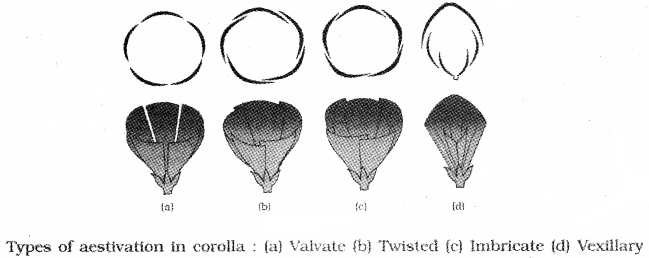
- In valvate sepals or petals in a whorl just touch one another at the margin, without overlapping, Eg -Calotropis
- In twisted the one margin of the appendage overlaps the next one and so on. g. china rose, lady’s finger and cotton
- In imbricate the margins of sepals or petals overlap one another but not in any particular direction. eg: Cassia and gulmohur
Can vou find out aestivation type in papillionaceous corolla?
There are five petals, the largest (standard) overlaps the two lateral petals (wings) which in turn overlap the two smallest anterior petals (keel). This is vexillary aestivation; Eg pea and bean flowers.
Androecium:
Structure of stamen:
Androecium is composed of stamens. Stamen is the male reproductive organ consists of a filament and an anther. Each anther is usually bilobed and each lobe has two chambers, the pollen-sacs. The pollen grains are produced in pollen-sacs. A sterile stamen is called staminode.
Differentiate between epibetalous and epiphvllous condition:
When stamens are attached to the petals, they are epipetalous as in brinjal, or epiphyllous when attached to the perianth as in the flowers of lily.
Free and fused nature of stamens:
The stamens in a flower remain free called as polyandrous. If the stamens are united into one bundle called as monoadelphous. eg: china rose, or two bundles called as diadelphous eg: pea, or into more than two bundles called as polyadelphous eg: citrus.
Variation in the length of filaments:
eg: Salvia and mustard.
Gynoecium:
Structure of carpel/pistil:
Gynoecium is the female reproductive part of the flower and is made up of one or more carpels. Acarpel consists of three parts namely stigma, style and ovary. Ovary is the enlarged basal part, on which lies the elongated tube, the style.
The style connects the ovary to the stigma. The stigma is the receptive surface for pollen grains. Each ovary bears one or more ovules attached to a flattened, cushion-like placenta.
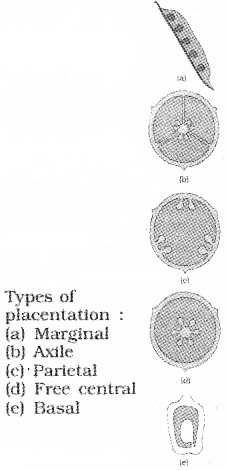
Free and fused nature of carpel:
If carpels are free they are called apocarpous, eg lotus and rose. If carpels are fused they are called syncarpous. eg: mustard and tomato.
What happens to ovule and ovary after fertilization?
After fertilisation, the ovules develop Into seeds and the ovary matures into a fruit.
Placentation:
The arrangement of ovules within the ovary is known as placentation. Different types of placentation are marginal, axile, parietal, basal, central and free central.
| Marginal placentation: the placenta forms a ridge along the ventral suture of the ovary and the ovules are borne on this ridge eg- pea. Axile placentation: When the placenta is axial and the ovules are attached to it in a multilocular ovary eg china rose, tomato and lemon. Parietal placentation: Ovary is one-chambered and the ovules develop on the inner wall of the ovary e.g., mustard and Argemone. Free central placentation: When the ovules are borne on central axis and septa are absent Eg Dianthus and Primrose Basal placentation: The placenta develops at the base of ovary and a single ovule is attached to it eg sunflower, marigold |
The Fruit:
It is a ripened ovary developed after fertilisation.
Parthenocarpic fruit:
If a fruit is formed without fertilisation of the ovary, it is called a parthenocarpic fruit. The fruit consists of a wall called pericarp and seeds.
Meaning of Drupe:
Fruit that develops from monocarpellary superior ovaries and are one seeded. Eg:- mango and coconut.
Different layers of pericarp:
In mango the pericarp is well differentiated into an outer thin epicarp, a middle fleshy edible mesocarp and an inner stony hard endocarp. In coconut fruit is drupe, the mesocarp is fibrous.

The Seed:
Seed consists of a seed coat and an embryo. The embryo is made up of a radicle, an embryonal axis, one cotyledons as in wheat, maize or two cotyledons as in gram and pea.
Structure of a Dicotyledonous Seed:
The seed coat has two layers, the outer testa and the inner tegmen. The hilum is a scar on the seed coat .Above the hilum is a small pore called the micropyle. It consists of an embryonal axis and two cotyledons. The cotyledons are fleshy and contains reserve food materials. At the two ends of the embryonal axis are present the radicle and the plumule.
What is non endospermic seed?
In plants such as bean, gram and pea, the endosperm is not present in mature seeds and such seeds are called non endospermous.
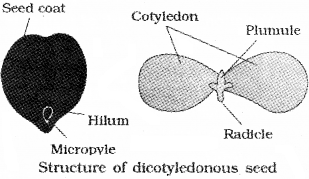
Structure of Monocotyledonous Seed:
Monocotyledonous seeds are endospermic but it is non-endospermic in orchids. The seed coat is membranous and fused with the fruit wall. The outer covering of endosperm separates the embryo by a proteinous layer called aleurone layer The embryo is situated in one end of the endosperm.
It consists of Vy one large and shield shaped cotyledon known as scutellum and a short axis with a plumule and a radicle. The plumule is enclosed in sheaths called coleoptile and radicle are enclosed in sheaths called as coleorhiza.
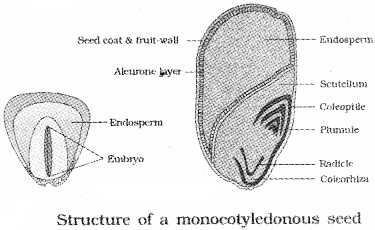
Some Technical Description Of A Typical Flowering Plant:
In the floral formula, Br stands for bracteate K stands for calyx, C for corolla, P for perianth, A for androecium and G for Gynoecium, for superior ovary and for inferior ovary, for male, for female, for bisexual plants, for for actinomorphicand forforzygomorphic nature of flower
Description Of Some Important Families:
Fabaceae (Papilonoideae ):
It is a subfamily of family Leguminosae.
Vegetative Characters:
- Stem: Erect or climber
- Leaves: alternate, pinnately compound or simple; leaf base, pulvinate; stipulate; venation reticulate.
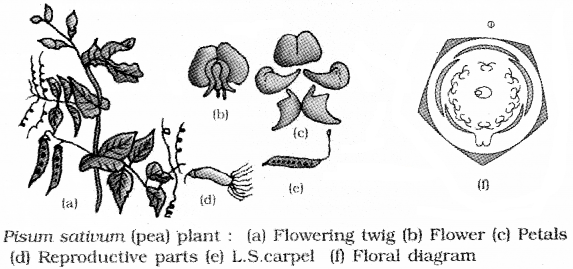

Economic importance:
Sources of pulses (gram, arhar.sem, moong, soyabean; Edible oil (soyabean, groundnut); dye (indigofera); Fibres (sunhemp); Fodder (Sesbania, Trifolium), Ornamentals (lupin, sweet pea) Medicine (muliathi).
Solanaceae (‘potato family’):
Vegetative Characters:
1. Stem:
herbaceous rarely woody, aerial; erect, cylindrical, branched, solid or hollow, hairy or glabrous, underground stem in potato (Solatium tuberosum).
2. Leaves:
alternate, simple, rarely pinnately compound, exstipulate; venation reticulate
Floral Characters:
- Inflorescence: Solitary, axillary or cymose as in Solanum
- Flower: bisexual, actinomorphic
- Calyx: sepals five, united, persistent, valvate aestivation
- Corolla: petals five, united; valvate aestivation
- Androecium: stamens five, epipetalous
- Gynoecium: bicarpellary, syncarpous; ovary superior, bilocular, placenta swollen with many ovules
- Fruits : berry or capsule
- Seeds: many, endospermous.
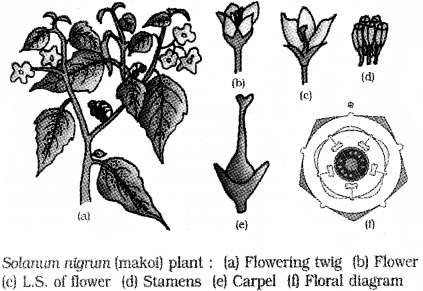

Economic Importance:
source of food (tomato, brinjal, potato)spice (chilli); Medicine (belladonna, ashwagandha) Fumigatory (tobacco); ornamentals (petunia).
Lilaceae (‘Lily family’):
Vegetative characters:
Perennial herbs with underground bulbs/corms/rhizomes. Leaves mostly basal, alternate, linear, exstipulate with parallel venation.
Floral characters:
- Inflorescence: solitary/cymose; often umbellate clusters.
- Flower: bisexual; actinomorphic
- Perianth: tepal six (3 + 3), often united into tube valvate aestivation.
- Androcium: stamen six, 3 + 3
- Gynoecium: tricarpellary, syncarpous, ovar ovules; axile placentation.
- Fruit: capsule, rarely berry
- Seed: endospermous
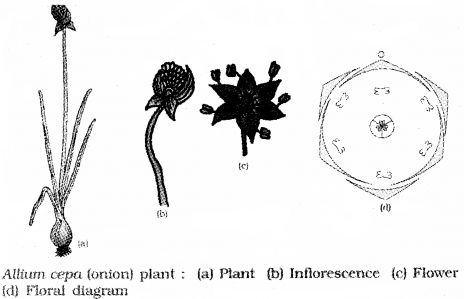

Economic Importance:
Ornamentals (tulip, Gloriosa), Source of medicine (Aloe), Vegetables (Asparagus), and colchicine (Colchicum autumnale).
